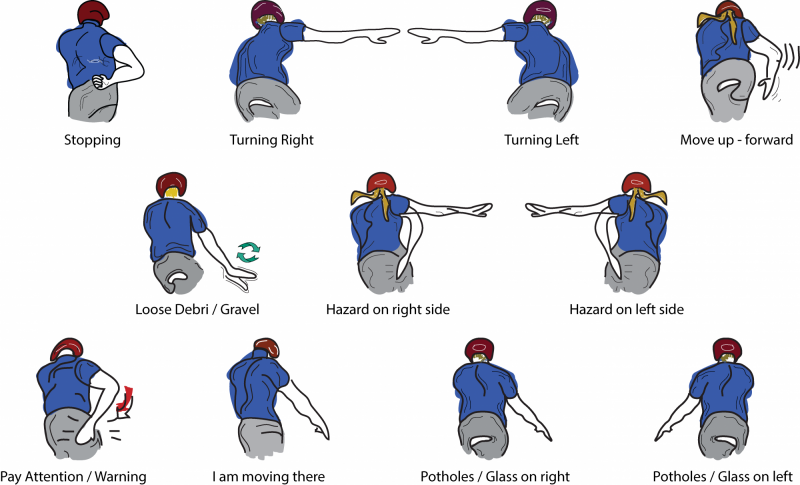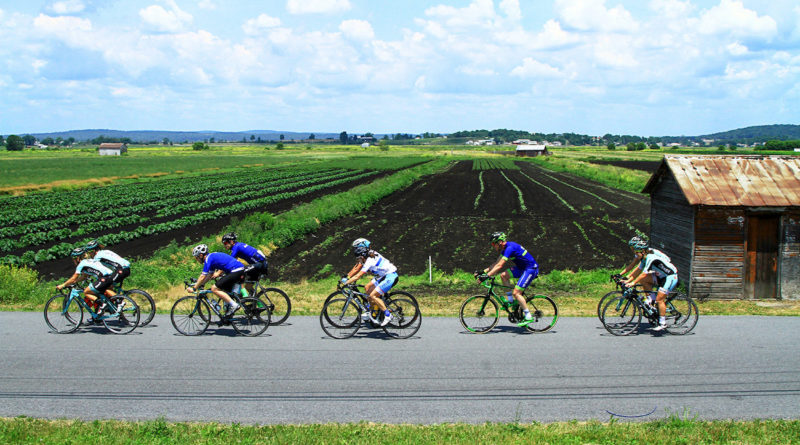14 Rules of Group Rides
By Stephen Gladstone
As a recreational rider, I never spent much time racing against the clock or riding with a group. I rode with friends. Occasionally, we would use a pace line and sometimes sprint for town lines but it was never anything organized or consistent.
Having ridden for many years with friends I was a bit intimidated by the prospect of joining a group ride. But when I finally got up the gumption to do so, I was amazed at how much I actually enjoyed it, how much better my riding got and how many new friends and biking buddies I added to my world.
So, about 20 years ago I started to do the Wednesday night ride with the Green Mountain Bike Club (GMBC). All of a sudden, I was riding in groups of 10 to 15 people, pushing hard on hills, holding my position in the line and taking my turn out front.
Riding in a pack, I had a chance to let the person ahead be a windbreak. By riding in a slipstream, you not only save energy (as much as 40 percent by some estimates) but you also help that person ride faster.
Paul Doherty, senior scientist at Exploratorium explains, “The interesting thing is by filling in their eddy you improve the front person’s performance as well. So, two people who are drafting can put out less energy than two individuals (who are not drafting) would to cover the same distance in the same time. While the lead cyclist gains some advantage in this situation they still need to expend much more energy than the cyclist who is following.”
Thus, getting sucked along in a pace line as a group we could move much faster than riding alone. Plus, watching the pedaling motion of the rider ahead helped me adjust my cadence.
This led to joining some of the longer group rides and organized events around Vermont. After all these years I have learned a number of things about riding in a pack which may seem obvious to those who have a racing background but are a bit of a revelation for amateurs.
This summer, group riding will be back. And for those who want to join in, here are a few tips I wish someone had shared with me so many years back.
1. COMMUNICATE
“Car back,” ”On your left,” “Hold your line,” “Slowing,” “Dropping,” and all the related hand signals (see page 13) are the lifeblood of a pack. There is no way that a group of people on bikes going 15 to 20+ mph can avoid catastrophe without constant and clear communication.
There is no such thing as too much information—knowing how to clearly and precisely transmit knowledge and information to others is a real skill that cannot be overstated.
At times I find it is the more experienced racers and riders who do not always communicate since they just assume you know and will do what is expected. Which leads to the next….
2. BE PREDICTABLE
A corollary to the communication among the pack is the assumption that your actions and others in the group are predictable. Hold a straight line when you peddle, avoid rapid accelerations or (worse) decelerations, pull out to the left when you want to drop back—the list is long of actions that you need to make very deliberately and predictably.
“No surprises” is really the motto here. There is a general protocol as well as rules-of-the-road that need to be learned. Don’t be afraid to ask and learn from others in the pack. The more you ride with a group, the more you will learn, and the easier it is to avoid the unexpected.
3. KNOW YOUR LIMITS
Quite often I find myself deciding if I can hold with the group. Is the pace and overall energy something I can sustain? Or, as I often say, “I think I am riding beyond my pay grade.” It is critical to know what energy level you can sustain for a long period of time. You may be able to hold on for a few miles, but then you pay the price later on. It is important to listen to your body and determine if you are up for it. If necessary, back off and find others more in line with your aerobic capacity and tolerance for pain.
4. PUSH THOSE LIMITS
Part of being able to hold with ”that group” is the ability to ride smart and efficiently. Many people have heart, cadence and speed monitors to measure effort and stay efficient. I find that in most cases we all know our limits without the need to check any devices. I can feel when I am at my limit and my body is not subtle about delivering a clear message. But if I can stay just below that zone and keep rolling, I am amazed at how far I can go as I push just below the point of exploding. The ability to run my engine almost into the red is a skill I have learned to appreciate and embrace.
5. BE EFFICIENT, KEEP THE RHYTHM
Part of pushing that limit is running efficiently. Just as your car has an “Eco-Drive” indicator where you get the best gas mileage, so too does your body have a zone of optimal efficiency. By paying attention to my cadence and power output, I am always working to be in the most efficient gear and to ride with the least amount of exertion. Once I find my rhythm, I try to hold it steady and adjust my gearing so the exertion level does not change until the road gets steep or the pace quickens.

6. TAKE YOUR TURN OUT FRONT
Part of that efficiency is being smart about your pulls. As the pace line flows and you find it is your turn at the front be ready for it. Try to be consistent. Pay attention to the speed of the pack before you get out front and are expected to hold the pace. This may require some gear shifting and, probably, an increase in exertion. But don’t speed up unless you feel the pack is with you. And be sure to not overstay your welcome. A short pull is fine—especially if the group is larger. If you can’t hold the speed then pull through and drop back quickly. Nobody benefits from your long slow pull. The group slows, the pack grumbles and you are exhausted as you pull out and try to catch the train as it accelerates by you.
7. PAY ATTENTION TO THAT WHEEL IN FRONT OF YOU
I must admit there have been times where I finish a ride and can barely remember any of the scenery. However, ask me about the rider in front of me and I can tell you all about the sponsors on their jersey, the slight wobble in the rear wheel, the clicking of the shifters and the kink in their left knee. It may not be the case for more experienced riders but I find it hard to relax when I am less than two feet from the wheel in front of me. I am getting better at looking forward and noticing where we are going but there is a constant vigilance to what is right in my face. How close should you get? The effects of drafting (getting sucked along in the slipstream of the rider ahead) get minimized the farther back you are. Strong riders will hover between 6 and 12 inches off the rear wheel of the rider ahead.
8. EAT AND DRINK EARLY AND OFTEN
Once you feel hungry or thirsty it is too late. I find a constant flow of a little water and a little food helps keep things in balance. I use the little gel cubes or mini shots. The bigger bars and GU are hard to swallow down when I am fully engaged just staying with the group. If there are stops or times when the group slows, I take those opportunities to consume quantities of food and gulp down the liquids.
9. MANAGE YOUR FLUIDS
There is nothing worse than getting a face full of water as the rider in front of you takes a drink and sprays water in all directions…No there is one thing worse, when said rider decides to clear their throat and/or nostrils without regard to where such liquids are heading. If Covid has taught us anything, it is that bodily fluids travel a great distance. Don’t be that person.
10. HYDRATE THE NIGHT BEFORE
It is amazing what drinking a large quantity of water the night before does to my overall hydration and energy during the ride. I am less sensitive to what I ate the night before, but I do try to not be stupid—a couple of Heady Toppers, a cheeseburger and Ben and Jerrys do not lend to fine form the next morning. I, for one, also need to have a full breakfast before a ride. I do much better fighting a little indigestion from my morning egg sandwich than the alternative of riding on an empty stomach. Add in a large cup of coffee and I am good to go.
11. DRESS FOR THE END OF THE RIDE, NOT THE BEGINNING
In cross country skiing there is a saying that, “if you are not cold at the start you are over-dressed”. Biking in summer is not that extreme. But realize that the difference between a cool morning and the midday sun is huge. So dress in easy-to-adjust layers that can be removed during a ride—arm warmers and vests offer a full range of combinations to match the weather.
12. BRING MONEY AND MAPS
While the latest GPS systems have pretty awesome coverage, I still find myself on rides where the old paper map is the best way to navigate, modify a route, and adjust for the latest paving project. Do not assume that you will be with others who know the route or that you will have cell coverage or that the local store takes your debit card. Cash is still king in the Northeast Kingdom.
13. REMEMBER IT IS NOT A RACE, BUT NEITHER IS IT A TOUR
There is a fine line during these rides of what happens when the pace is too fast for some riders—does the group back off to accommodate the slower riders—after al,l it is not a race. Or does the group keep going and drop the slower members—after all this is not some Sunday tour. There is no hard or fast rule for any of this and I have been on both sides of the debate—the person being dropped and part of the group doing the dropping. Perhaps the best advice is to realize stuff happens and while discussing things before the ride is always a good thing, once people get on their bikes the best of intentions are not always kept. So, don’t take it personally if you find yourself in no man’s land as the pack leaves you in the dust.
14. FOCUS ON THE JOURNEY, NOT THE DESTINATION…OR YOUR AVERAGE SPEED
Enjoy the ride and the experience and the way your body feels afterward. Those are the rewards. Ralph Waldo Emerson wrote “To finish the moment, to find the journey’s end in every step of the road, to live the greatest number of good hours, is wisdom.” Emerson never rode in a pack but he was right about enjoying the process and not to focus too much on the results or your average speed. Those all disappear as soon as you reset the bike computer for your next ride.


